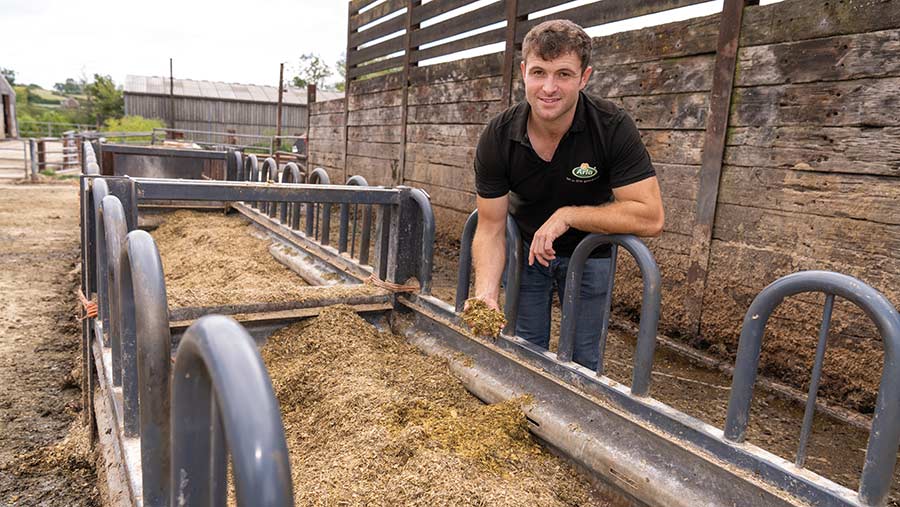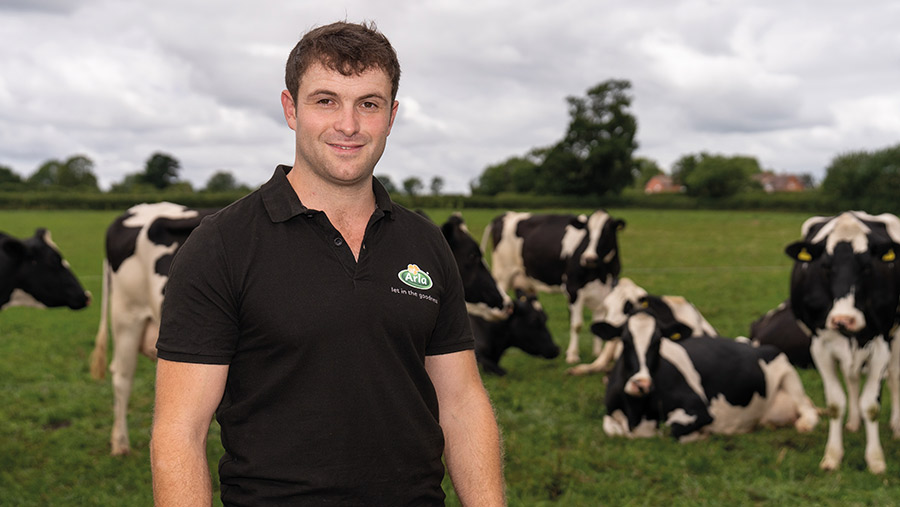How forage maize no-till system cuts costs and improves soil
 © MAG/Tom Askew-Miller
© MAG/Tom Askew-Miller No two years are the same in farming, as Max Tite’s experience of growing maize with minimal soil disturbance shows.
But, with the right weather conditions, he has found that a no-tillage approach to growing forage can reduce establishment costs and soil carbon loss, with just a small yield sacrifice.
Mr Tite farms at Newmans Farm, near Sturminster Newton, Dorset, with his parents, Elizabeth and Paul, where they produce milk from a herd of autumn-calving Holstein-Friesians.
High-quality forage underpins their approach to milk production, and central to that is maize. An average of 77ha (190 acres) is grown annually.
See also: What are the pros and cons of min-till maize?
“Maize is one of the most efficient feeds you can grow because its yield is so high,” Mr Tite says, calculating that it gives the best return a cow a hectare.
On-farm trial
In his first year of trialling no-tillage, savings at the establishment stage ranged from £366 to £494/ha (£148-£200/acre).
The saving depended on the soil type, with heavier soils requiring greater intervention with a power-harrow.
Mr Tite achieved an average yield of 37t/ha (15t/acre) compared with 42t/ha (17t/acre) in his conventionally grown maize.
The following year, he increased the area grown using this method to 12ha, and achieved similar results.
However, his results in 2021 from growing 32ha (79 acres) of no-till maize highlight just how crucial soil temperature is at the establishment stage.
The wet, cold conditions that set in after drilling meant the crop was very slow to establish, especially on the heavy clay soils. A proportion was so poor it had to be redrilled.
Only the maize on lighter soils – just a quarter of the entire crop – reached its full potential. The rest achieved 60-80% of the yield produced by the conventionally tilled crop.
“It cost us money in 2021, but luckily it was an excellent grass year, so we didn’t have a forage shortfall,” Mr Tite admits.
The part-failure of the 2021 crop has not deterred him from using no-tillage establishment this year.
Farm facts: Newmans Farm, Sturminster Newton, Dorset
- Farming 200ha (494 acres)
- 200 Holstein Friesian cows
- Average milk yield of 9,528 litres, with 5,930 litres from forage
- 4.42% butterfat and 3.58% protein rolling average
- Concentrate use/ litre of 0.18kg
- Milk supplied to the Tesco Sustainable Dairy Group through Arla
“It is all a learning curve,” he reasons. “Had we planted earlier we might have got away with it, but planting early suits what we are trying to do.
“We had a very dry start to 2021 and thought the no-tillage maize was going to win because the moisture retention in that soil was better at establishment. But the conditions changed to cold and wet after we planted.”
One change Mr Tite is considering is to subsoil the fields with heavier clay soil to promote drainage.
Soil health
No-till allows farmers to grow crops with minimal disturbance to the soil and the organisms that live in it, increasing soil health while reducing costs.
For Mr Tite, this is one of the main reasons for adopting this approach for part of his maize crop.
“Soil health is massively important to us going forward,” he says.
His journey began in 2015: the business had been using two to three passes with a power-harrow at establishment, but this was becoming harder.
As the organic matter became depleted, bigger soil aggregates formed and these were difficult to break down.
Mr Tite researched alternatives to reduce tillage, improve soil structures and minimise the environmental impact of growing maize.
“The better the condition of the soil, the better it is able to retain moisture, so there is less run-off and leaching,” he reasons.
He switched to non-inversion tillage and reduced the number of passes.
“Rather than routinely going in with a set number, regardless of the soil condition, we now check the soil and only power-harrow when it is needed.”

© MAG/Tom Askew-Miller
Cover crops
Another change was the introduction of cover crops, mostly brassicas. Now they are planted in all maize fields after harvesting to reduce the environmental impact of cultivation and improve soil health.
Last year he grew a cover crop mix of spring oats, phacelia, tillage radish and a forage rape/hybrid brassica.
“The soils improved, seed-bed preparation became easier, quicker and cheaper because the soil was more friable, and this led us to want more improvement,” says Mr Tite.
With more research, the family came to realise their goal would be no-till, for its soil carbon, cost saving and time efficiency benefits.
Establishment
After cover cropping and carrying no overwintered maize stubble for a couple of years, the first 2ha of no-till maize was grown using a Weaving GD drill.
“Our contractor, A&R Fraser, was already no-tilling cereal crops and gave us lots of advice, even though no-till maize drilling was a first for them,” says Mr Tite.
“The crop was a success, with only a slight loss of yield at a much lower cost of establishment and less soil carbon loss.”
Soils are top-dressed with fertiliser, with calcium ammonium nitrate (27% nitrogen) applied just after drilling at a rate of 300kg/ha (121kg/acre) and di-ammonium phosphate delivered through the drill spout at 60kg/ha (24kg/acre).
More recently, the maize has been drilled with a precision maize drill, a Vaderstad Tempo.
“Our long-time contractor, Phill Bennett, uses it on our conventionally established maize,” says Mr Tite. “In the first year of using it on our no-tillage land he spent a long time adjusting it in order to achieve what we were after.
“He has used his experience to help other farmers in the area to trial no-till.’’
Varietal choice
Mr Tite has used the early variety LG Glory for all the farm’s no-tillage maize. This trait is important for an early harvest to allow a cover crop to be established, he says.
It also scores highly on metabolisable energy (ME), consistently analysing at 11.5% ME, with a starch level of 28%.
Max Tite’s tips for growing no-tillage forage maize
- Assess the soil condition of the fields earmarked for growing by digging holes. This will provide a guide as to whether they are suitable for no-tillage
- For successful no-till, soils must not be compacted. Ideally, there will be pre-existing root structures creating pores down through the soil for the maize roots to move through
- Seek advice from a seed merchant on which varieties are best suited to no-tillage – Mr Tite says he had important guidance from his seed supplier, Ken Tuffin of Pearce Seeds.
